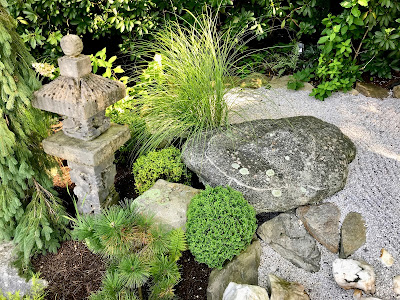I had an opportunity to visit Shôyôan Teien of the Mansfield Freeman Center of East Asian Studies at Wesleyan University in Middletown, Connecticut.
The garden is located behind the Center and can be visited by entering through the front entrance. Once in, look for a small Japanese style room (Shôyôan - usually found in traditional Japanese homes). Once you enter, you can then view the garden (Shôyôan Teien) from within the room or exit onto a viewing deck (Engawa). However, do not enter or walk within the garden. It is not a Japanese stroll garden, but a viewing garden. One merely sits on the deck and contemplates what it would be like to walk through the landscape.
Website: https://www.wesleyan.edu/ceas/about/Japanese%20Garden%20and%20Tea%20Room.html
As usual, I am seeing a garden in summer - lots of green. This garden is best visited in spring and fall, when some color will emerge. I liked the rectangular shape of the garden, it reminded me of gardens I had visited in Kyoto and in some way my own backyard Zen garden. I would advise not visiting around noon time - the sun was directly above-center and was blinding. Photography was difficult with all that glare and It was unusually hot the day I visited - no contemplation for me, unless you consider heat exhaustion contemplation.
The garden was built in 1995 and it has evolved since then. There was, as there in every garden, the need for some weeding and plant maintenance, but overall the garden looked nice. I liked the winding nature of the path and the way it evoked the curving of the nearby Connecticut river.
Overall, Shôyôan Teien is a great garden and well worth a visit.



















































